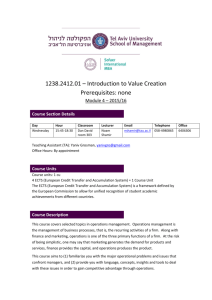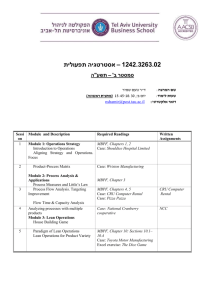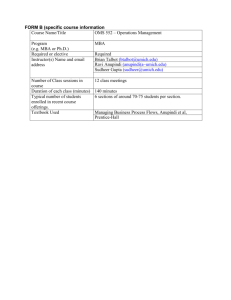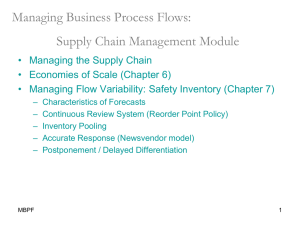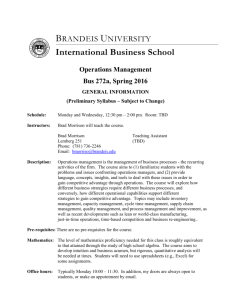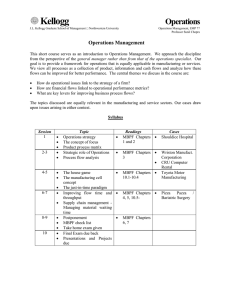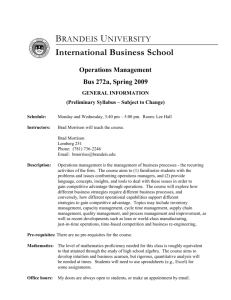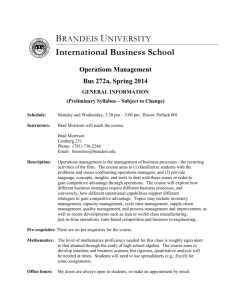MBA and M.Sc. Courses 1242.3263.01 – Operations Strategy First
advertisement
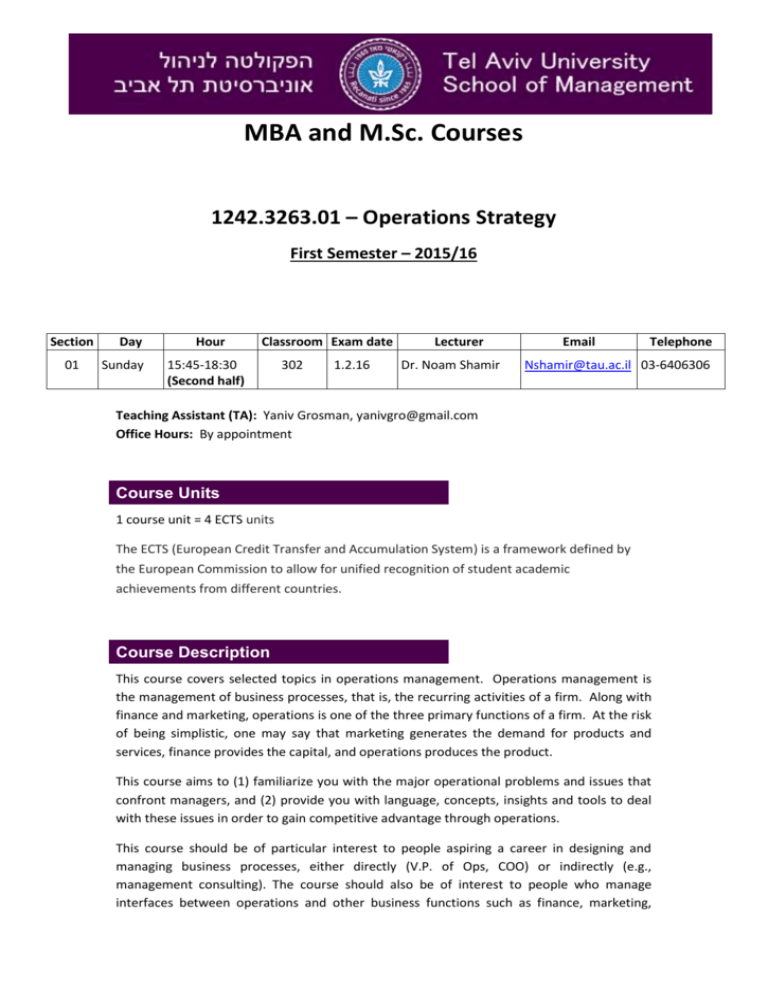
MBA and M.Sc. Courses 1242.3263.01 – Operations Strategy First Semester – 2015/16 Section 01 Day Sunday Hour Classroom Exam date 15:45-18:30 (Second half) 302 1.2.16 Lecturer Dr. Noam Shamir Email Telephone Nshamir@tau.ac.il 03-6406306 Teaching Assistant (TA): Yaniv Grosman, yanivgro@gmail.com Office Hours: By appointment Course Units 1 course unit = 4 ECTS units The ECTS (European Credit Transfer and Accumulation System) is a framework defined by the European Commission to allow for unified recognition of student academic achievements from different countries. Course Description This course covers selected topics in operations management. Operations management is the management of business processes, that is, the recurring activities of a firm. Along with finance and marketing, operations is one of the three primary functions of a firm. At the risk of being simplistic, one may say that marketing generates the demand for products and services, finance provides the capital, and operations produces the product. This course aims to (1) familiarize you with the major operational problems and issues that confront managers, and (2) provide you with language, concepts, insights and tools to deal with these issues in order to gain competitive advantage through operations. This course should be of particular interest to people aspiring a career in designing and managing business processes, either directly (V.P. of Ops, COO) or indirectly (e.g., management consulting). The course should also be of interest to people who manage interfaces between operations and other business functions such as finance, marketing, managerial accounting and human resources. Finally, a working knowledge of operations, which typically employs the greatest number of employees and requires the largest investment in assets, is indispensable for general managers and entrepreneurs. We will see how different business strategies require different business processes, and vice versa, how different operational capabilities allow and support different strategies to gain competitive advantage. A process view of operations will be used to analyze different key operational dimensions such as capacity management, flow time management, supply chain management, and quality management. We will also discuss developments such as lean operations and just-in-time operations. Course Objectives Upon completion of the course, the student will be able to: 1. Understand the major operational problems and issues that confront managers. 2. Understand the language, concepts, insights and tools to deal with these issues in order to gain competitive advantage through operations. Evaluation of Student and Composition of Grade The grade you receive for the course is intended to certify your demonstrated proficiency in the course material. Proficiency will be estimated by measuring your performance on (1) class contribution, (2) homeworks and (3) exam. The final exam will be an in-class exam. It will be comprehensive, covering material from all course modules. Percentage 10% 15% Assignment Active class participation Case analysis – CRU 15% Case analysis – NCC 60% Final exam Date Group Size/Comments Individual The beginning of meeting #3 The beginning of meeting #5 1.2.16 Up to 4 students Up to 4 students Individual * According to University regulations, participation in all classes of a course is mandatory (Article 5). * Students who absent themselves from classes or do not actively participate in class may be removed from the course at the discretion of the lecturer. (Students remain financially liable for the course even if they are removed.) Course Assignments CASE ANALYSIS The case write-ups are to be done in teams. The goal of the team approach to case prep is to have you think and experiment while sensitizing you to those issues that are novel and that will be further discussed in class. Each case write-up should address the questions indicated in the detailed class schedule below. In preparing your write-up, please adhere to the following guidelines: Be concise and well-structured: Recommendations should be summarized on the first page and be complemented by a crystal clear discussion on how these follow from your analysis. Your write up should not exceed 2 pages of text (11pt, 1 ½ lines spaced), not including exhibits. (Remember: 2 pages is a limit, not a quota.) Be to the point: Know that you write to someone who knows the facts of the case; focus on your explaining – and making a clear case for – your recommendations. Be punctual: Late submissions will not be accepted. CLASS CONTRIBUTION In-class contribution will consist mainly of voluntary contributions, although I may call upon students to encourage broader participation. Grading Policy In the 2008/9 academic year the Faculty instituted a grading policy for all graduate level courses that aims to maintain a certain level of the final course grade. Accordingly, this policy will be applied to this course's final grades. Additional information regarding this policy can be found on the Faculty website. Evaluation of the Course by Student Following completion of the course students will participate in a teaching survey to evaluate the instructor and the course, to provide feedback for the benefit of the students, the teachers and the university. Course Site (Moodle) The course site will be the primary tool to communicate messages and material to students. You should check the course site regularly for information on classes, assignments and exams, at the end of the course as well. Course material will be available on the course site. Please note that topics that are not covered in the course material but are discussed in class are considered integral to the course and may be tested in examinations. Course Outline* Session 1 Module and Description Required Readings Module 1: Operations Strategy MBPF, Chapters 1, 2 Introduction to Operations Written Assignments Case: Shouldice Hospital Limited Aligning Strategy and Operations. Focus 2 Product-Process Matrix Module 2: Process Analysis & Applications Case: Wriston Manufacturing MBPF, Chapter 3 Process Measures and Little’s Law 3 Process Flow Analysis. Targeting Improvement Flow Time & Capacity Analysis 4 MBPF, Chapters 4, 5 Case: CRU Computer Rental CRU Computer Rental Case: Pizza Pazza Module 3: Lean Operations House Building Game 5 Paradigm of Lean Operations Case: National Cranberry cooperative Lean Operations for Product Variety MBPF, Chapter 10: Sections 10.1–10.4 Case: Toyota Motor Manufacturing Excel exercise: The Dice Game NCC Session 6 Module and Description Required Readings Written Assignments Module 4: Service Operations Management MBPF: Chapter 8. The BAT case Case: The BAT case Capacity, Queueing and Flow Time Analysis Evaluation of service systems Design of service systems (Pooling vs. Segregation, Specialization vs. Flexibility) Priority (Fast Track) The impact of limited buffers 7 Priority (Fast Track) The impact of limited buffers Course wrap-up *Subject to change Module 1: Operations Strategy Class 1a: Introduction to Operations Objective: Characterize “operations management” and its link to business strategy to gain competitive advantage. Required Reading: MBPF, Chapter 1. Preparation Questions: 1. In a business context, what is meant by operations? 2. What are the competitive priorities of a typical (service or manufacturing) business? 3. What role does operations management play in achieving these? Class 1b: Aligning Strategy and Operations. Focus. Objective: Illustrate how to do a strategic operational audit to align strategy and operations. Discuss the notion of focused operations, its advantages and challenges. Required Reading: MBPF, Chapter 2. Case: Shouldice Hospital. Be prepared to discuss the following questions: 1. Apply the process view to Shouldice Hospital: what are the key process features? 2. What are Shouldice’s competitive priorities? What kind of market have they chosen to focus on? How does their operations strategy support their business strategy? Class 2a: Product-Process Matrix. Case: Wriston Corporation: The Detroit Plant. Be prepared to discuss the following questions: 1. Why do overhead costs (Exhibit 2) vary so greatly from plant to plant in Wriston’s manufacturing network? Why have managers in the Heavy Equipment Division underinvested in the Detroit Plant? 2. Perform a rough NPV analysis of the three options given on the first page of the case using the data in Exhibit 7. What option is most attractive from a financial perspective? 3. What option would you recommend using the strategic framework introduced in class 1? Specifically, what should Richard Sullivan do with the Detroit Plant? Justify your recommendation. Module 2: Process Analysis and Applications Class 2b: Process Measures and Little’s Law Objective: Introduce the fundamental process measures throughput, inventory and flow time, and Little’s Law, the key relationship among the three. Required Reading: MBPF, Chapter 3. Class 3a: Process Flow Analysis. Targeting Improvement Objective: Discuss where to target improvement using process flow charts and fundamental process performance measures such as flow time, inventory and throughput. Written Assignment: CRU Computer Rentals. We will discuss the questions listed at the end of the case in class. Address the following questions in your write-up: 1. What is the process at CRU? Make a flow chart clearly identifying activities, routes and any other data given in the case. 2. What do you think about the decision to launch a sales drive this year? 3. What actions would you suggest Richard focus on to improve performance at CRU? Make concrete recommendations and indicate anticipated benefits. 4. What are the key performance measures Richard should focus on? Note: your qualitative discussion should be backed by quantitative analysis. Note: In addition to submitting a hard copy of your write up in class, submit a file with your process flow chart. Recommended MBPF textbook problems: 3.1, 3.5 Class 3b: Flow Time & Capacity Analysis Objective: Discuss the drivers of flow time and capacity. Required Reading: MBPF, Chapters 4, 5. Class 4a: process analysis with multiple products Module 3: Lean Operations Class 4b: House Building Game Objective: Explore the relationship between process structure and performance (cost, quality and time) through a team-based simulation game. Class 5: Paradigm of Lean Operations Objective: Introduce, drawing on your house game experience, the paradigm of lean operations with its focus on attaining an ideal process through waste reduction. Required Reading: MBPF, Chapter 10: Sections 10.1 – 10.4. Case: Toyota Motor Manufacturing USA. Prepare the following questions for discussion: Identify if, and if so where, Toyota carries inventory and excess capacity. How exactly does Toyota respond to a cord pull? a) What is the cost of an average cord pull resulting in a stoppage of 1 minute, 30 minutes, or 60 minutes? b) Based on your financial estimate, what is your qualitative assessment of the practice of letting employees stop the line? c) Now, focusing on seats only: Do you think the line should be stopped when the station identifies a defective seat? What is the value of a cord pull? What actions does Toyota take to lower the cost of a line stoppage? Interactive exercise: The Dice Game from The Goal. Module 4: Service Operations Management Class 6a: Capacity, Queuing & Flow Time Analysis Objective: Introduce congestions and queuing phenomena and discuss managerial actions that mitigate queuing’s negative impact on operational performance. Required Reading: MBPF: Chapter 8. Recommended problems: 8.1, 8.4, 8.5, 8.8. Class 6b: Design of service systems (Pooling vs. Segregation, Specialization vs. Flexibility, Priorities) Objective: Show how queuing theory can be used as a tool for managing service operations facing time-sensitive customers. Required Reading: LS&S call center. No assignment due on this case. The BAT case. The BAT Case. Question 1 is intended to help you review whether providing better service to all customers is feasible and how this would change if BOP! Team 1 saw either a higher or lower volume of calls. The remaining questions aim at evaluating the Fast Track proposal. The write-up should address Question 7. 1) Given the current arrival rate, what would it take to offer a one minute average wait for all customers? What is the utilization of the system? How would these values change if the arrival rate increased or decreased by 25%? 2) Suppose Grayson implements Fast Track by keeping BOP! Team 1 together as one team and giving priority to Fast Track calls. What staffing levels are needed to deliver a oneminute Fast Track wait for the demand rates that the consultants have forecasted? If additional technicians are needed, is Fast Track economically viable? 3) Is promising a one-minute wait sufficient or should they have service be free when the wait exceeds one minute? Is the program viable if BAT provides free service to all Fast Track callers who have a wait over one minute? 4) What is the impact of Fast Track on standard calls? Holding the staffing level constant how does the difference in the waiting time of standard and Fast Track calls change as the arrival rate falls to 20 calls per hour or rises to 25 calls per hour? 5) How should BAT implement Fast Track? Should BOP! Team 1 be kept as one team or should it be split into separate subteams, dedicated to either Fast Track or standard calls? (Assume that the standard call subteam has to be big enough to keep the average wait below current levels.) 6) Should BAT offer service contracts or just pay-per-call service? 7) What is the economic return on implementing Fast Track? Would you implement Fast Track? Clearly explain why or why not. You may want to use the Excel workbook Queue.xls to analyze this case. It is available from the class web site. Required Reading Slides will be made available a week before the first class. 1. Course pack: cases. 2. Managing Business Process Flows: Principles of Operations Management (MBPF) by Anupindi, Chopra, Deshmukh, Van Mieghem and Zemel. Prentice Hall, (any edition will be fine) Recommended Reading 1. The Machine that Changed the World: The Story of Lean Production by James P. Womack, Daniel T. Jones and Daniel Roos, Harper Perennial, 1991. 2. Chasing The Rabbit: How Market Leaders Outdistance the Competition and How Great Companies Can Catch Up and Win, by Steven Spear, McGraw-Hill, 2008. 3. Call Center Management on Fast Forward: Succeeding in Today's Dynamic Customer Contact Environment by Brad Cleveland, ICMI Press, 2006. 4. Matching Supply with Demand: An Introduction to Operations Management by Gerard Cachon and Christian Terwiesch, McGraw-Hill/Irwin; 2 edition 2008. 5. Supply Chain Management (4th ed) by S.C. Chopra and P. Meindl, Prentice Hall, 2009. 6. Operations Strategy: Principles and Practice by J.A. Van Mieghem, Dynamic Ideas, 2008.
